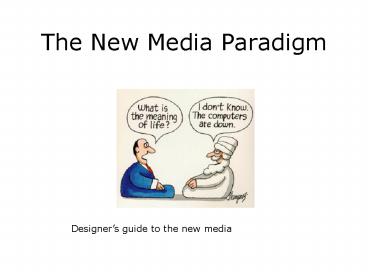The New Media Paradigm - PowerPoint PPT Presentation
1 / 43
Title:
The New Media Paradigm
Description:
Websites, Games, eCommerce, Virtual Communities, Mobiles, CD-ROM... Email & mobile phone = interpersonal. Video conferencing = group communication ... – PowerPoint PPT presentation
Number of Views:86
Avg rating:3.0/5.0
Title: The New Media Paradigm
1
The New Media Paradigm
Designers guide to the new media
2
A paradigm shift
3
A paradigm shift
4
Welcome to the new media paradigm!
5
overlap
- communication science
- social and cultural aspects
- The transmission of information between humans
computer science electronic aspects, information
technologies The transmission of bits between
computers
human to computer
computer to human
computer to computer
human to human
Interactive Multimedia
6
Studying MultimediaDeveloping a New Media
Literacy
- Tony Sampson
- Senior Lecturer
- University of East London
7
A paradigm shift
Old media Discrete analogue media forms Print,
TV, Radio
Revolution Digitisation
New media All media digital now Increasing
choice and access
Crisis Need to re-skill for digital
8
paradigm shift
- increases levels of
- Convergence
- Interactivity
Websites, Games, eCommerce, Virtual Communities,
Mobiles, CD-ROM
9
Historical shifts in communication
- Face to face the spoken word one to
a few - Mass communication the printed word, broadcast
media
one to many - Computer mediated the Internet many to
many
10
Complex New Media
- New Media Forms
- Networked Computer
- Internet
- Video conferencing
- Games
- Mobiles
- Infotainment
- Edutainment
- Types of Communication
- Intrapersonal
- individual use of mass information
- Group multi-users
- Face-to-face -Interpersonal
- Above all new media is
- interactive
11
New Media-New Literacy
- New media producer
- require a new literacy
- Learning to produce and consume new media
- Creating new communication experiences
- Using new applications
- Designing navigational information spaces
- Exploiting the potential of interactivity
- Understanding the market for new products
12
Academic overlapWhat we teach at University
- communication science
- social and cultural aspects
- The transmission of information between humans
computer science electronic aspects, information
technologies The transmission of bits between
computers
human to computer
computer to human
computer to computer
human to human
Interactive Multimedia
13
New Media-New Literacy-New Student
- Multimedia education is designed for students who
want to understand computers media
communication - Renaissance
- Technology
- Creativity
- Can design an interesting game or engaging
website - Can use the tools to producer it
- Ability to find technological solutions to
creative problems
14
Specific Key Skills
- Plan, design and produce interfaces and content
- Web pages and CD-ROM
- Interactive virtual environments and games
- Manipulate and edit
- Digital images
- Digital sound video
- Manage and maintain
- Working with clients on major projects
- Working in groups
- Develop an understanding of
- The culture of new media and its place in society
15
- Examples of student work
16
1940-50s
- We are little switchboard centres handling and
rerouting the great endless current of
information.... - Schramm W. (1954) quoted in McQuail Windahl
(1981)
17
(No Transcript)
18
Paradigm shifts in communication
- Face to face the spoken word one to a few
- Mass communication the printed word one to
many - Computer mediated the internet many to many
19
Paradigm shifts in communication
- Games intrapersonal
- Email mobile phone interpersonal
- Video conferencing group communication
- Internet individual use of mass information
- Above all new media is
- Highly interactive
20
Interactivity
Seen by many as the central component of the new
media paradigm shift
21
interactivity
Interactivity is based on changing roles of
sender/receiver
22
Interaction defined
message
Communicator A
Communicator B
Response/reaction
response
Communicator A
Bretz (1983) Hanssen, Jankowski and Etienne 1996
Contours of Multimedia
23
Three levels of interactionRafaeli (1988)
- Bidirectionality
- (CD-ROM)
- Reactiveness
- (Web page)
- Responsiveness
- (email, computer game)
24
Users and interactivity
- Research by Hanssen, Jankowski and Etienne in
1994 - Participants regarded control over sequence as
interactive
- The greater number of choices meant the greater
amount of interactivity experienced
25
Users and interactivity
- Too much control on one side of the communication
is experienced negatively
- Decision-making moments functioned as obstacles
to use - A degree of linearity and editorial structure
aided user orientation
26
The truth ismost multimedia
- Is not very interactive
27
going back" and going to the previous page
28
Design
- Linear
- Grids
- Hierarchical Semantic Network
29
Linear Sequence
30
Grid
31
Hierarchy
32
Hierarchy
33
Design for growth
34
Design for growth
35
Design for growth
36
Web or semantic net
37
Confused mental model
38
summary
39
Apply to audience
40
Should multimedia strive to be interpersonal?
- Key ingredients of interpersonal communication
(Borsock and Higginbotham Wheat, 1991)
- Immediacy of response
- Non-sequential access to information
- Adaptability
- High levels of feedback
41
What should multimedia be?
- Tannenbaum argues that a good mix of
- interactivity
- social presence (telepresence)
- makes good multimedia
42
Assumptions about face to face communication
- Jones (1995)
- CMC has become a race to provide the most
lifelike interaction possible
- However, problems exist with interpersonal
face-to-face interaction - absence of information
- the silence and pauses between words and phrases
- It does not necessarily break down barriers of
communication.
43
Should all multimedia be interactive?
- from the perspective of functionality, it is not
necessary to always strive for a high degree of
interactivity Hanssen, Jankowski and Etienne,
1996
- Technology can often get in the way of clarity of
message































